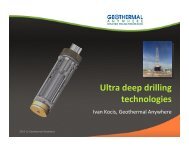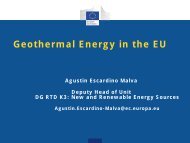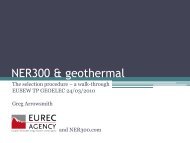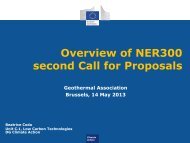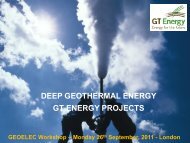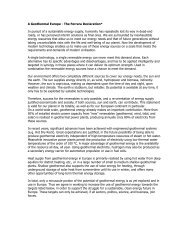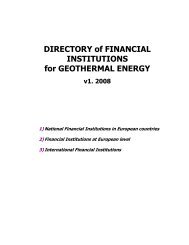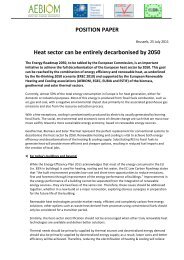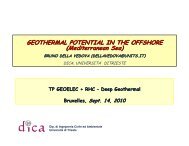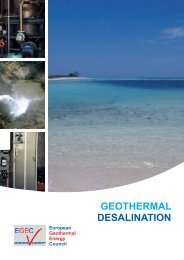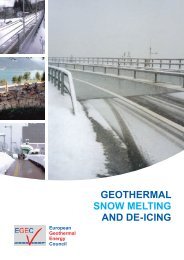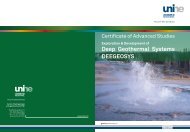Strategic Research and Innovation Agenda for Renewable ... - EGEC
Strategic Research and Innovation Agenda for Renewable ... - EGEC
Strategic Research and Innovation Agenda for Renewable ... - EGEC
Create successful ePaper yourself
Turn your PDF publications into a flip-book with our unique Google optimized e-Paper software.
3<strong>Strategic</strong> <strong>Research</strong> <strong>and</strong> <strong>Innovation</strong> <strong>Agenda</strong> <strong>for</strong> <strong>Renewable</strong> Heating & CoolingRHC applications <strong>and</strong> priorities <strong>for</strong> residential buildingsGEO.1GEO.2GEO.3<strong>Research</strong> <strong>and</strong> <strong>Innovation</strong> Priorities Predominant type of activity ImpactOptimisation of ground-coupling technology(i.e. technology to exchange heat with the groundin an optimal way)Improving the underst<strong>and</strong>ing of the shallowgeothermal reservoir<strong>Research</strong> on pipe material <strong>for</strong> borehole heatexchangers (BHE) or horizontal ground loops140Development By 2020Development By 2020<strong>Research</strong> By 2030Table 5: research <strong>and</strong> innovation priorities <strong>for</strong> geothermal applications to residential buildings3.5 Cross-Cutting Technologies100Electrically driven heat pumps trans<strong>for</strong>m low temperatures renewable energy fromthe air, ground or water to heat at higher temperature that can be used <strong>for</strong> space heating,heating water 80 or cooling. Energy from these sources is - with certain exceptions due to localconditions (geology, soil <strong>and</strong> climate) - available everywhere in Europe at all times. In addition,heat pumps are 60 able to use low-temperature BHE cost waste heat (e.g. from industrial processes,sewage water or exhaust air of buildings) BHE length as an energy source <strong>and</strong> create high-temperatureheat from it. By saving energy compared to conventional heat generation systems, heat pumpsincrease the share 40 of renewable energy in total final energy consumption.1985 1990 1995 2000 2005 2010 2015 2020yearProperly designed <strong>and</strong> installed heat pump systems are highly efficient <strong>and</strong> can fullymeet the heat dem<strong>and</strong>s of many areas of application. On a final energy basis, theiroutput originates from 66% to 80% from renewable energy. Considering their primaryenergy consumption, their efficiency depends on the efficiency with which the auxiliaryfuel needed to 140run them (most often electricity) was generated.%As shown in Figure 17, air source units today can achieve efficiencies of around 140 % in terms120of primary energy. Electrically driven heat pumps are today’s predominant solution <strong>for</strong> spaceheating <strong>and</strong> cooling in residential as well as non-residential buildings. In terms of technologydevelopment, 100 manufacturers continue the relentless drive <strong>for</strong> improved overall systemper<strong>for</strong>mance, achieved in general through optimised components <strong>and</strong> moreattention to the 80 delivery of completely integrated solutions (Figure 18). This underlinesthe importance of the heat pump’s interplay with the heat distribution system, <strong>and</strong> a need tofocus on more intelligent <strong>and</strong> integrated System controls. first cost The emergence of hybrid systems (heatpumps deployed 60 in conjunction with Heat other full cost renewable or conventional heating solutions)highlights the acceptance of the technology Electricity as consumption part of an integrated energy efficient solutionin both the retrofit 40 <strong>and</strong> new-build sectors. Heat pump based hybrid systems can meet therequirements of nearly 1985 100% 1990 of the 1995 heating 2000market.2005 2010 2015 2020year%120Specific Costs of Solar Cooling Kits [EUR/kW cold]90008000700060005000400030002000100002007 2008 2009small capacity up to 10kWTank thermal energy storage (TTES)(60 to 80 kWh/m 3 )Borehole thermal energy storage (BTES)(15 to 30 kWh/m 3 )614051204100sCOP321%8060BHE cost (€BHE efficien050CHP01992 1996 2000 2004 2008 201220162020401990 1995 200028Figure 17: Trend <strong>and</strong> potential efficiency evolution of sCOP <strong>for</strong> electrically driven air towater heat pumps in heating mode. Per<strong>for</strong>mance described by the seasonal Coefficien1.8Of Per<strong>for</strong>mance (sCOP). (Source: EHPA)1.61.41.21.0UE350300250200



